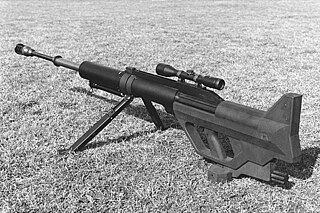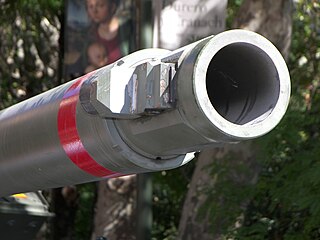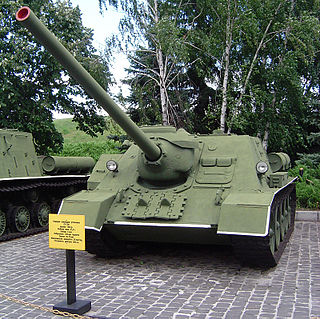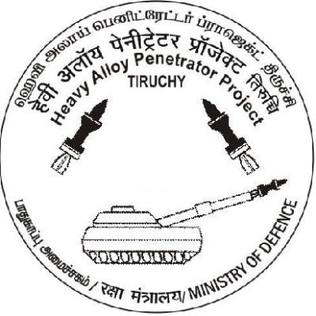
A kinetic energy penetrator (KEP), also known as long-rod penetrator (LRP), is a type of ammunition designed to penetrate vehicle armour using a flechette-like, high-sectional density projectile. Like a bullet or kinetic energy weapon, this type of ammunition does not contain explosive payloads and uses purely kinetic energy to penetrate the target. Modern KEP munitions are typically of the armour-piercing fin-stabilized discarding sabot (APFSDS) type.

Armour-piercing ammunition (AP) is a type of projectile designed to penetrate armour protection, most often including naval armour, body armour, vehicle armour.

Terminal ballistics is a sub-field of ballistics concerned with the behavior and effects of a projectile when it hits and transfers its energy to a target.

A sabot is a supportive device used in firearm/artillery ammunitions to fit/patch around a projectile, such as a bullet/slug or a flechette-like projectile, and keep it aligned in the center of the barrel when fired. It allows a narrower projectile with high sectional density to be fired through a barrel of much larger bore diameter with maximal accelerative transfer of kinetic energy. After leaving the muzzle, the sabot typically separates from the projectile in flight, diverting only a very small portion of the overall kinetic energy.

The Steyr IWS 2000 is an Austrian single-shot bolt-action anti-materiel rifle produced by Steyr Mannlicher. IWS stands for Infantry Weapon System. Unlike other anti-tank rifle designs, it has a smoothbore barrel. This facilitates higher projectile velocities and allows a longer barrel service life, but the lack of gyroscopic spin-stabilization requires the projectile to have aerodynamic stabilizing fins instead. The IWS is chambered in a 15.2×169 mm armor-piercing fin-stabilized discarding-sabot cartridge, and is the first man-portable rifle to use this type of ammunition.

Armour-piercing discarding sabot (APDS) is a type of spin-stabilized kinetic energy projectile for anti-armour warfare. Each projectile consists of a sub-calibre round fitted with a sabot. The combination of a lighter sub-calibre projectile with a full-calibre propellant charge allows for an increase in muzzle velocity compared to full-calibre rounds, giving the round increased armour-penetration performance. To further enhance their armour-penetration capabilities, APDS rounds typically feature a hardened core made from tungsten or another hard, dense material.

A tank gun is the main armament of a tank. Modern tank guns are high-velocity, large-caliber artilleries capable of firing kinetic energy penetrators, high-explosive anti-tank, and cannon-launched guided projectiles. Anti-aircraft guns can also be mounted to tanks.
The following is a list of ammunition fired by the 125 mm smoothbore gun series used in the T-64, T-72, T-80, M-84, T-90, PT-91, T-14 Armata, and other tanks derived from those designs, as well as the 2A45 Sprut anti-tank gun.

The Rheinmetall Rh-120 is a 120 mm smoothbore tank gun designed and produced in former West Germany by the Rheinmetall-DeTec AG company, it was developed in response to Soviet advances in armour technology and development of new armoured threats. Production began in 1974, with the first version of the gun, known as the L/44 as it was 44 calibres long, used on the German Leopard 2 tank and soon produced under license for the American M1A1 Abrams and other tanks. The 120-millimetre (4.7 in) gun has a length of 5.28 metres (17.3 ft), and the gun system weighs approximately 3,317 kilograms (7,313 lb).

The M829 is an American armor-piercing fin-stabilized discarding sabot (APFSDS) tank round. Modeling was done at the Ballistic Research Laboratory at Aberdeen Proving Ground, which was incorporated into the Army Research Laboratory in 1992. The round is specifically designed for the 120 mm M256 main gun on the Abrams M1A1 and M1A2 main battle tanks. The penetrator is carried by a sabot during its acceleration in the gun barrel.
The XM1111 Mid-Range Munition (MRM) is a 120 mm precision guided munition developed for the Rheinmetall Rh-120 120mm gun used by several Western tanks. It was also intended to fulfill a requirement for Future Combat Systems (canceled) for a long-range, beyond line of sight (BLOS) tank munition.

The D-10 is a Soviet 100 mm tank gun developed in late World War II. It originally equipped the SU-100 tank destroyers and was later selected for the T-55 tank, equipping these as late as 1979. On the T-55 the D-10 continues to be in active service in many countries.

Armour-piercing fin-stabilized discarding sabot (APFSDS), long dart penetrator, or simply dart ammunition is a type of kinetic energy penetrator ammunition used to attack modern vehicle armour. As an armament for main battle tanks, it succeeds Armour-Piercing Discarding Sabot (APDS) ammunition, which is still used in small or medium caliber weapon systems.

The L30A1, officially designated Gun, 120 mm, Tank L30,is a British-designed 120 mm rifled tank gun, installed in the turrets of Challenger 2 main battle tanks. It is an improved production model of the Royal Ordnance L11 series of rifled tank guns. Challenger 2 tanks, and their L30A1 guns, are operated by the British and Omani armies. In 2023, L30A1 armed Challenger 2 tanks supplied by the British were delivered to Ukraine.
The CBU-107 Passive Attack Weapon (PAW) is an air-dropped guided bomb containing metal penetrator rods of various sizes. It was designed to attack targets where an explosive effect may be undesirable, such as fuel storage tanks or chemical weapon stockpiles in civilian areas.
The saboted light armor penetrator (SLAP) family of firearm ammunition is designed to penetrate armor more efficiently than standard armor-piercing ammunition. In the US it was developed by the Marine Corps during the mid/late 1980s and was approved for service use in 1990 during Operation Desert Storm. It uses a reduced caliber, heavy metal (tungsten) .30 inch diameter penetrator wrapped in a plastic sabot of .50 inch diameter, and the .308 SLAP round was a .223 inch diameter penetrator core within the .308 inch plastic sabot.

The High Energy Projectile Factory (HEPF) is an artillery ammunition factory operated by Munitions India Limited. It was previously part the erstwhile Ordnance Factories Board of the Government of India the factory is located about 25 kilometres from the main city of Tiruchirappalli.

The Royal Ordnance L11A5, officially designated Gun 120 mm Tk L11, is a 120 mm L/55 rifled tank gun design. It was the first of NATO's 120 mm main battle tank guns which became the standard calibre for Western tanks in the later period of the Cold War. A total of 3,012 of the L11 guns were produced by 2005. The list price was US$227,000 in 1990.

120×570mm NATO tank ammunition, also known as 120×570mmR, is a common, NATO-standard, tank gun semi-combustible cartridge used by 120mm smoothbore guns, superseding the earlier 105×617mmR cartridge used in NATO-standard rifled tank guns.

The CN08 is a 120 mm 55-caliber smoothbore gun produced by Hyundai WIA. It is incorrectly known as the licensed production of the Rheinmetall Rh-120 L/55, but it was indigenously developed by the Agency for Defense Development and WIA from 2003 to 2008 for the XK2 development project started in 1995. The development was completed after the field test ended in September 2008.













